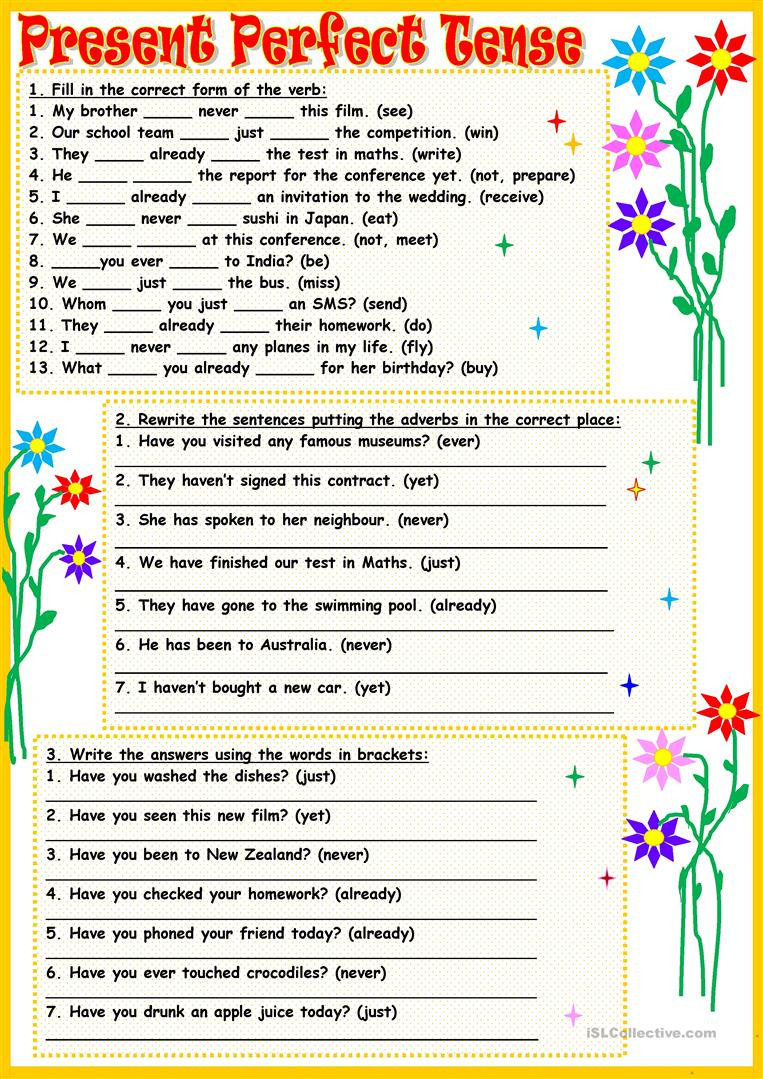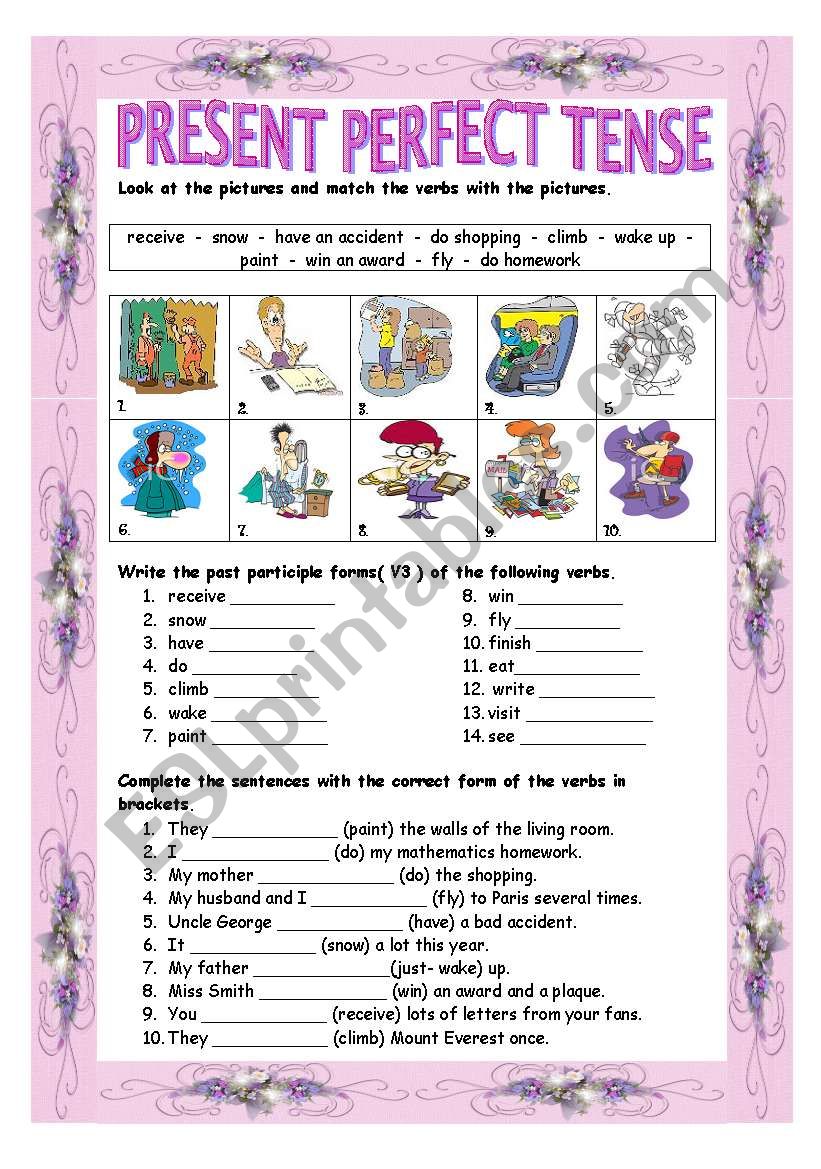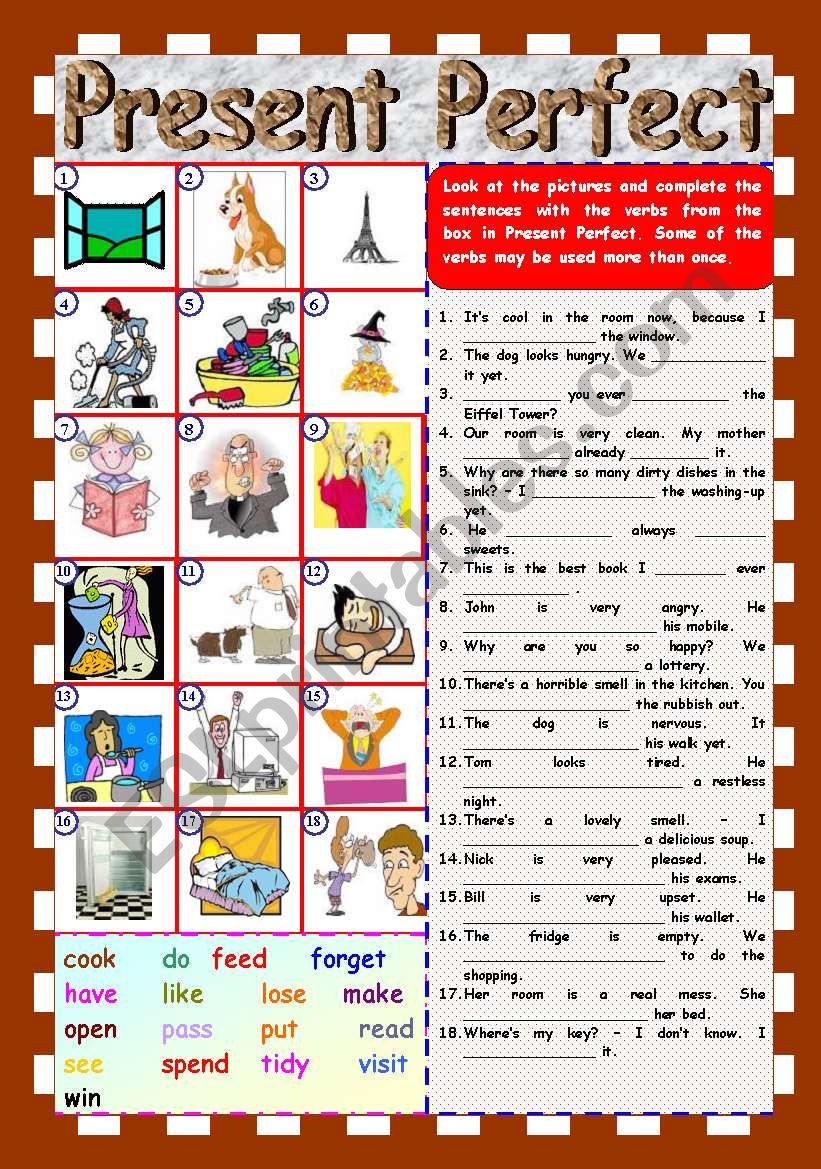
Mastering the Nuances: The Indispensable Role of Present Perfect Worksheets
The Present Perfect tense in English often stands as a formidable challenge for language learners. Unlike the straightforward past tense, which simply describes completed actions at a definite time, the Present Perfect delves into a more nuanced realm, connecting past events to the present moment. Its complexity stems from its varied uses – describing experiences, actions that started in the past and continue into the present, recent actions with present results, and events that occurred at an unspecified time. For both educators and students, navigating this grammatical landscape requires consistent practice and targeted reinforcement. This is precisely where Present Perfect worksheets emerge as an invaluable, indeed indispensable, tool.
This comprehensive article will explore the profound significance of Present Perfect worksheets, delving into their various types, the principles of designing effective ones, and strategies for maximizing their impact in the language learning journey. We will argue that far from being mere busywork, these structured exercises are a cornerstone of successful Present Perfect acquisition, providing the scaffolding necessary for learners to confidently use this often-tricky tense.
The Intricacies of the Present Perfect: Why Worksheets Are Essential

Before diving into the specifics of worksheets, it’s crucial to understand why the Present Perfect poses such a unique learning hurdle. Many languages lack a direct equivalent, leading to confusion when learners try to translate directly from their native tongue. For instance, the distinction between "I went to Paris last year" (Simple Past) and "I have been to Paris" (Present Perfect) can be subtle but significant. The former specifies a completed action at a definite time, while the latter describes an experience that holds relevance in the present.

Furthermore, the Present Perfect is frequently paired with specific adverbs and time expressions such as "for," "since," "ever," "never," "already," "yet," and "just." Understanding the correct placement and meaning of these words within the tense structure adds another layer of complexity.

Present Perfect worksheets provide a structured environment for learners to confront these intricacies head-on. They isolate the grammatical concepts, allowing students to focus on form, meaning, and usage without the added pressure of spontaneous conversation. Through repeated exposure and varied exercises, learners can gradually internalize the rules and develop an intuitive feel for when and how to apply the tense correctly.

The Multifaceted Benefits of Present Perfect Worksheets
The advantages of incorporating Present Perfect worksheets into a language curriculum are manifold:
-
Reinforcement and Repetition: Language acquisition, especially grammar, thrives on repetition. Worksheets offer a systematic way to practice conjugations (have/has + past participle), sentence construction, and the application of rules across various contexts. This consistent exposure helps solidify understanding and moves the knowledge from short-term memory to long-term retention.
-
Targeted Practice for Specific Uses: As mentioned, the Present Perfect has multiple functions. Well-designed worksheets can dedicate sections to each use case – for example, one page for "experiences," another for "actions continuing to the present" with "for" and "since," and yet another for "recent actions with present results." This targeted approach allows learners to master one aspect before moving to the next.

-

Identification of Common Errors: Worksheets often highlight recurring mistakes. If a student consistently uses the Simple Past instead of the Present Perfect in a specific scenario, the worksheet will reveal this pattern, allowing the teacher to provide focused feedback and intervention. Similarly, error correction exercises on worksheets specifically train students to identify and correct these common pitfalls.
-
Building Confidence: Successfully completing exercises on a worksheet provides a sense of accomplishment. As students correctly fill in blanks, choose the right tense, or construct accurate sentences, their confidence in using the Present Perfect grows, encouraging them to apply it in spoken and written communication.
-
Flexibility in Learning Environments: Worksheets are incredibly versatile. They can be used for in-class practice, homework assignments, self-study, or even as diagnostic tools to assess prior knowledge or identify areas needing more attention. Their printable nature makes them accessible even without internet connectivity.
-
Developing Analytical Skills: Many worksheet exercises require students to analyze sentences, identify keywords, and make choices based on context. This process hones their analytical thinking skills, which are crucial not just for language learning but for broader academic success.


Types of Effective Present Perfect Worksheets
To be truly effective, Present Perfect worksheets must offer a diverse range of exercise types that cater to different learning styles and address various aspects of the tense. Here are some key categories:
1. Form and Structure Drills: The Foundation
These worksheets focus on the mechanics of the Present Perfect.
- Conjugation Tables: Simple exercises where students practice forming the past participle of regular and irregular verbs, and then combine them with "have" or "has." E.g., "I (go) __ to the market." -> "I have gone to the market."
- Gap-Fill Sentences (Basic): Sentences with a blank where students need to insert the correct Present Perfect form of a given verb.
- Sentence Scramble: Jumbled words that students must rearrange to form grammatically correct Present Perfect sentences.
- Error Correction: Sentences with a Present Perfect error (e.g., incorrect auxiliary, wrong past participle, missing word) that students need to identify and fix. This is excellent for developing an eye for detail.
- Negative and Interrogative Transformations: Exercises requiring students to change affirmative Present Perfect sentences into negative statements or questions.
2. Contextual Usage and Meaning: Applying the Rules
Once the form is established, these worksheets focus on when and why to use the Present Perfect.
- Present Perfect vs. Simple Past Discrimination: This is perhaps the most critical type of exercise. Students are given sentences or short paragraphs where they must choose between the Present Perfect and Simple Past based on time expressions, context, or implied meaning. E.g., "I (visit) __ Rome last year." vs. "I (visit) __ Rome three times."
- "For" vs. "Since" Exercises: Scenarios where students choose the correct time expression to indicate duration or starting point. E.g., "She has lived here (for/since) __ 2010." or "They have studied English (for/since) __ five years."
- Adverb Placement Exercises: Students practice correctly placing adverbs like "already," "yet," "just," "ever," "never" within Present Perfect sentences. E.g., "I (already/finish) __ my homework."
- Scenario-Based Questions: Short prompts or situations that require students to formulate a Present Perfect answer. E.g., "You see your friend looking tired. Ask them what they have been doing."
- Picture Prompts: Students describe what has happened in a series of images using the Present Perfect.
3. Integrated Skills Worksheets: Beyond Pure Grammar
Truly effective Present Perfect worksheets extend beyond isolated grammar points, integrating with other language skills.
- Reading Comprehension with Present Perfect Focus: A short text (e.g., a diary entry, a news report) where students answer comprehension questions that specifically require them to identify or formulate Present Perfect sentences.
- Writing Prompts: Students write short paragraphs or stories using the Present Perfect to describe personal experiences, recent events, or ongoing situations. E.g., "Write about three things you have never done but want to do."
- Dialogue Completion/Creation: Students fill in blanks in a conversation or create their own dialogues using the Present Perfect to discuss experiences or recent news. This can lead into speaking practice.
- Sentence Transformation (Active/Passive): Exercises where students transform sentences from active to passive voice (or vice versa) while maintaining the Present Perfect tense.
- Listen and Complete: Students listen to an audio clip and fill in missing Present Perfect verbs or phrases in a transcript.
Designing and Adapting High-Quality Present Perfect Worksheets
The effectiveness of Present Perfect worksheets hinges significantly on their design and how they are used.
- Clear and Concise Instructions: Students should immediately understand what is expected of them. Use simple, unambiguous language.
- Varied Exercise Types within a Single Worksheet: To maintain engagement and address different aspects of the tense, mix up exercise formats (e.g., gap-fill, matching, true/false, open-ended questions).
- Gradual Increase in Difficulty: Start with simpler, controlled practice and progressively introduce more complex structures or contextual choices. This builds confidence and prevents overwhelm.
- Relevance and Context: Wherever possible, make the content relatable to students’ lives or current events. Using authentic or semi-authentic contexts makes the learning more meaningful.
- Visual Appeal: Don’t underestimate the power of good design. Use clear fonts, appropriate spacing, and relevant images or graphics to make the worksheet inviting and easy to navigate.
- Provide Examples: Always include one or two completed examples for each new exercise type to guide students.
- Answer Keys: For self-study or peer-correction, a clear answer key is invaluable. It empowers students to take ownership of their learning and receive immediate feedback.
- Differentiation: Consider creating versions of a worksheet that cater to different proficiency levels within the same class. This could involve providing word banks for lower levels or more challenging open-ended questions for advanced learners.
Maximizing the Impact of Present Perfect Worksheets in the Classroom
Worksheets are not meant to be isolated activities. Their true power is unleashed when integrated strategically into a broader lesson plan.
- Pre-teaching and Concept Explanation: Always introduce the Present Perfect concept thoroughly before distributing worksheets. Explain its uses, form, and common time expressions.
- Guided Practice: Begin by doing the first few exercises together as a class, clarifying any doubts.
- Collaborative Learning: Encourage pair or group work. Students can discuss answers, explain their reasoning to each other, and learn from their peers. This also fosters communication skills.
- Feedback and Correction: Don’t just collect and grade. Go over the answers, highlight common errors, and provide constructive feedback. Use error correction as a teaching moment.
- Follow-Up Activities: After completing a worksheet, transition to a speaking or writing activity that requires students to use the Present Perfect in a more communicative way. For example, after a "for/since" worksheet, have students interview each other about how long they have lived in their current city or studied English.
- Using Worksheets as Diagnostic Tools: Before starting a unit on Present Perfect, a short diagnostic worksheet can help gauge students’ existing knowledge and pinpoint areas that need more attention.
Beyond the Worksheet: Complementary Activities
While Present Perfect worksheets are foundational, they should be part of a holistic approach to language learning. Complementary activities include:
- Real-Life Conversations: Encourage students to talk about their experiences, recent news, or ongoing situations using the Present Perfect.
- Games: Board games, card games, or online quizzes specifically designed to practice the Present Perfect can make learning fun.
- Storytelling: Have students create chain stories where each person adds a sentence using the Present Perfect.
- Authentic Materials: Bring in news articles, song lyrics, or video clips where the Present Perfect is used naturally, and analyze its function.
- Technology Integration: Utilize online interactive exercises, grammar apps, or digital whiteboards to provide dynamic practice.
Conclusion
The Present Perfect tense, with its subtle connections between past and present, demands a precise and methodical approach to learning. In this context, Present Perfect worksheets are far more than just paper exercises; they are carefully constructed tools that provide the essential scaffolding for mastery. From reinforcing basic forms to clarifying nuanced meanings and integrating with communicative skills, well-designed and strategically implemented worksheets offer the repetitive, targeted practice necessary for learners to internalize this vital grammatical structure.
Ultimately, the strategic use of Present Perfect worksheets empowers students to move beyond rote memorization, fostering a deep understanding and confident application of this indispensable tense in their English communication. By embracing their versatility and designing them thoughtfully, educators can transform a potential stumbling block into a stepping stone towards advanced linguistic proficiency.
